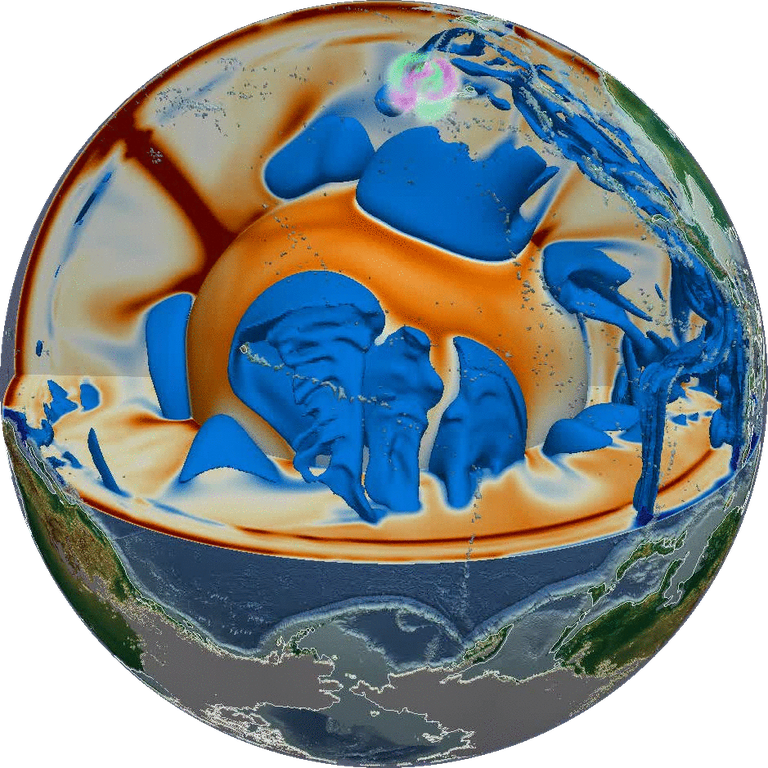Research
My research is focused on a multidisciplinary approach combining computational seismology, geodynamics and mineral physics, which aims at a better understanding of deep Earth structure and dynamics. I have addressed problems regarding the accuracy of numerical methods for 3-D seismic wave propagation, the generation of synthetic models of mantle heterogeneity based on dynamic flow calculations, and the analysis of their thermal and elastic signature as well as a quantitative assessment of their seismic expressions against tomography. Recently, I have set up a novel joint forward modeling framework that can serve as a complementary tool to tomographic inversions: geodynamically derived models of seismic mantle structure are used in simulations of global wave propagation (Fig. 1). This way, specific hypotheses on mantle dynamics can be tested directly against seismic data.

Figure 1. Snapshots of the three-dimensional wavefield in one of our geodynamic models. 3-D global wave propagation was simulated for an earthquake in the Fiji Islands region using a spectral element technique. The wavefield is depicted by green and magenta colours together with the shear wave velocity variations in the model, for which vertical cross-sections and iso-surfaces are shown on a blue to brownish colour scale ranging from -2 to 2 per cent. Surface topography is also shown for parts of the globe for geographic reference [Schuberth et al. 2012].
Methods and tools involved:
- Large-scale high-performance computations
- Spectral element techniques for 3-D (an-)elastic wave propagation
- 3-D finite element modelling of global mantle circulation
- ``Tomographic Filtering'' of geodynamic models
i.e., Multiplication with the resolution operator to mimic the effects of uneven data coverage and damping in tomographic inversions
- Non-linear temperature to seismic velocity scalings using thermodynamic mineralogical models
CV
Since March 2012, I am senior research scientist in Geodynamics at LMU Munich. I finished my PhD in 2009 and between 2010 and 2012, I was a Marie-Curie Fellow at Géoazur, Université de Nice - Sophia Antipolis in France working together with Guust Nolet on problems of wave propagation in mantle circulation models.
My main curriculum at university was Geophysics with a strong focus on computational seismology and training in high-performance computing. Later, during my Ph.D., I concentrated on theoretical Geodynamics and increased my experience in scientific programming and knowledge on numerical simulations on parallel high-performance computing platforms.
Publications
2025
-
Chen, Yi-Wei and Wu, Jonny and Bunge, Hans-Peter and Stotz, Ingo L. and Robl, Gabriel and Schuberth, Bernhard S. A. (2025), Tomopac2: an unfolded-slab plate reconstruction validated via mantle circulation models in a closed-loop experiment , 481(2318), doi: 10.1098/rspa.2024.0726.
-
Robl, Gabriel and Schuberth, Bernhard S. A. and Papanagnou, Isabel and Thomas, Christine (2025), From seismic models to mantle temperatures: Uncertainties related to mineralogical complexities and limited tomographic resolution , 241(3), 2003-2027, doi: doi.org/10.1093/gji/ggaf141.
2021
-
Schuberth, Bernhard S.A. and Bigalke, Tobias (2021), From Mantle Convection to Seismic Observations: Quantifying the Uncertainties Related to Anelasticity AGU Geophysical Monograph Series, vol. 263, pp. 97-120, Hoboken, NJ, USA, John Wiley & Sons Inc., Editors: Marquardt, H. and Ballmer, M. and Cottaar S. and Konter, J., doi: 10.1002/9781119528609.ch4.
-
Gabriel, Alice-Agnes and Mohr (corr.), Marcus and Schuberth, Bernhard S.A. (2021), Geocomputing Encyclopedia of Earth Sciences Series, Springer, Cham, ISBN: 1871-756X, Editors: Sagar, B. S. Daya and Cheng, Qiuming and McKinley, Jennifer and Agterberg, Frits, doi: 10.1007/978-3-030-26050-7, open access at https://bit.ly/3mHpUKA.
2019
-
Simmons, N. A. and Schuberth, B. S. A. and Myers, S. C. and Knapp, D. R. (2019), Resolution and Covariance of the LLNL-G3D-JPS Global Seismic Tomography Model: Applications to Travel time Uncertainty and Tomographic Filtering of Geodynamic Models , 217(3), 1543–1557, doi: 10.1093/gji/ggz102.
-
Chow, Bryant and Wassermann, Joachim and Schuberth, Bernhard S. A. and Hadziioannou, C\’eline and Donner, Stefanie and Igel, Heiner (2019), Love wave amplitude decay from rotational ground motions , 218(2), 1336–1347, doi: 10.1093/gji/ggz213.
2015
-
Schuberth, Bernhard S. A. and Zaroli, Christophe and Nolet, Guust (2015), Traveltime dispersion in an isotropic elastic mantle: strong lower-mantle signal in differential-frequency residuals , 203(3), 2099–2118, doi: 10.1093/gji/ggv389.
-
Colli, Lorenzo and Bunge, Hans-Peter and Schuberth, Bernhard (2015), On retrodictions of global mantle flow with assimilated surface velocities , 42(20), 8341–8348, doi: 10.1002/2015GL066001.
-
Amodeo, Jonathan and Schuberth, Bernhard and Bunge, Hans-Peter and Carrez, Philippe and Cordier, Patrick (2015), On the role of thermal heterogeneities on the rheology of MgO under conditions of the Earth's lower mantle , 242, 1-8, doi: 10.1016/j.pepi.2015.02.008.
2014
-
Zaroli, C. and Leveque, J.-J. and Schuberth, B.S.A. and Duputel, Z. and Nolet, G. (2014), Global S-wave tomography using receiver pairs: an alternative to get rid of earthquake mislocation , 199(2), 1043-1057, doi: 10.1093/gji/ggu312.
-
Butterworth, N.P. and Talsma, A.S. and Müller, R.D. and Seton, M. and Bunge, H.-P. and Schuberth, B.S.A. and Shephard, G.E. and Heine, C. (2014), Geological, tomographic, kinematic and geodynamic constraints on the dynamics of sinking slabs , 73, 1-13, doi: 10.1016/j.jog.2013.10.006.
2013
-
Johnson, Chris, et al. (2013), PRACE DECI (Distributed European Computing Initiative) Minisymposium , pp. 43–60, Berlin, Heidelberg, Springer Berlin Heidelberg, ISBN: 978-3-642-36803-5, Editors: Manninen, Pekka and Öster, Per, doi: 10.1007/978-3-642-36803-5_3.
2012
-
Davies, D.R. and Goes, S. and Davies, H.J. and Schuberth, B.S.A. and Bunge, H.-P. and Ritsema, J. (2012), Reconciling dynamic and seismic models of Earth's lower mantle: The dominant role of thermal heterogeneity , 353, 253-269, doi: 10.1016/j.epsl.2012.08.016.
-
van Driel, Martin and Wassermann, Joachim and Nader, Maria Fernanda and Schuberth, Bernhard and Igel, Heiner (2012), Strain rotation coupling and its implications on the measurement of rotational ground motions , doi: 10.1007/s10950-012-9296-5.
-
Schuberth, Bernhard S.A. and Zaroli, Christophe and Nolet, Guust (2012), Synthetic seismograms for a synthetic Earth: long-period P- and S-wave traveltime variations can be explained by temperature alone , 188(3), 1393--1412, doi: 10.1111/j.1365-246X.2011.05333.x.
-
Shephard, G. E. and Bunge, H-P. and Schuberth, B.S.A. and Müller, R.D. and Talsma, A.S. and Moder, C. and Landgrebe, T. (2012), Testing absolute plate reference frames and the implications for the generation of geodynamic mantle heterogeneity structure , 317-318, 204--217, doi: 10.1016/j.epsl.2011.11.027.
2009
-
Schaber, K. and Bunge, H.-P and Schuberth, B. and Malservisi, R. and Horbach, A. (2009), Stability of the rotation axis in high-resolution mantle circulation models: Weak polar wander despite strong core heating , 10, doi: doi:10.1029/2009GC002541, doi:10.1029/2009GC002541.
-
Schuberth, Bernhard (2009), Thermal, Elastic and Seismic Signature of High-Resolution Mantle Circulation Models. Dissertation, LMU München: Faculty of Geosciences , Ludwig-Maximilians-Universität München, Fakultät für Geowissenschaften.
-
Schuberth, B. S. A. and Bunge, H.-P. and Ritsema, J. (2009), Tomographic filtering of high-resolution mantle circulation models: Can seismic heterogeneity be explained by temperature alone? , 10(5), doi: 10.1029/2009GC002401.
-
Schuberth, B. S. A. and Bunge, H.-P. and Steinle-Neumann, G. and Moder, C. and Oeser, J. (2009), Thermal versus elastic heterogeneity in high-resolution mantle circulation models with pyrolite composition: High plume excess temperatures in the lowermost mantle , 10(1), doi: 10.1029/2008GC002235.
2007
-
Bunge, H. and Steinle-Neumann, G. and Piazzoni, A. and Schuberth, B. and Moder, C. and Oeser, J. (2007), Global mantle circulation models with thermodynamically self consistent mineralogy: bridging the geodynamic/seismic gap , pp. A4+.
-
Schuberth, B. and Piazzoni, A. and Bunge, H. and Igel, H. and Steinle-Neumann, G. and Moder, C. and Oeser, J. (2007), Self-consistent Synthetic Mantle Discontinuities From Joint Modeling of Geodynamics and Mineral Physics and Their Effects on the 3D Global Wave Field , pp. B9+.
-
Moder, Christoph and Bunge, Hans-Peter and Igel, Heiner and Schuberth, Bernhard (2007), Visualization of large datasets with Paraview .
-
Moder, Christoph and Bunge, Hans-Peter and Igel, Heiner and Schuberth, Bernhard (2007), Visualization in the Geosciences with Paraview and Geowall , pp. 147-155, Berlin, Lehmanns Media, ISBN: 9783865412164, Editors: Benger, Werner and Heinzl, René and Kapferer, Wolfgang and Schoor, Wolfram and Tyagi, Mayank and Venkataraman, Shalini and Weber, Gunther.
2006
-
Suryanto, W., et al. (2006), First comparison of seismic array derived rotations with direct ring laser measurements of rotational ground motion , 96(6), 2059-2071, doi: 10.1785/0120060004.
-
Schuberth, Bernhard and Piazzoni, Antonio and Igel, Heiner and Bunge, Hans-Peter and Steinle-Neumann, Gerd (2006), The Role of Forward Modeling of Seismic Waveforms for Interpretation of Mantle Structure, Physics and Composition , Abstract S53C-08 in Eos Trans. AGU, 87(52), Fall Meet. Suppl..
-
Schuberth, B. and Piazzoni, A. and Igel, H. and Bunge, H.-P. and Steinle-Neumann, G. (2006), Global Seismic Wave Field Effects of Geodynamically Derived 3-D Mantle Structures , Abstr.Nr. 07722 in Geophysical Research Abstracts, Vol. 8.
-
Käser, M. and Igel, H. and de la Puente, J. and Schuberth, B. and Bunge, H.P. (2006), Erdbebenforschung durch Höchstleistungsrechnen , No.02/2006, Bayerische Akademie der Wissenschaften - Akademie Aktuell.
-
Cochard, A., et al. (2006), Rotational motions in seismology: theory, observations, simulation , Springer Verlag, Editors: Teisseyre et al..
2005
-
Schuberth, B. and Piazzoni, A. and Igel, H. and Bunge, H.-P. (2005), Simulation of 3D Global Wave Propagation Through Geodynamic Models , Abstract Book (ISBN 80-223-2074-9).
-
Schuberth, B. and Piazzoni, A. and Igel, H. and Bunge, H.-P. and Steinle-Neumann, G. (2005), Simulation of 3D Global Wave Propagation Through Geodynamic Models , Abstract NG43B-0570 in Eos Trans. AGU, 86(52), Fall Meet. Suppl.
-
Schuberth, B. and Ewald, M. and Igel, H. and Treml, M. and Wang, H. and Brietzke, G. (2005), Computational Seismology: Narrowing the Gap Between Theory and Observations , pp. 251-262, Springer Verlag, ISBN: 978-3-540-26145-2, Editors: Bode, A. and Durst, F..
-
Schreiber, U. and Igel, H. and Cochard, A. and Velikoseltsev, A. and Flaws, A. and Schuberth, B. and Drewitz, W. and Müller, F. (2005), The GEOsensor Project: a new observable for seismology , Springer Verlag, Editors: BMBF.
-
Igel, H. and Schreiber, U. and Flaws, A. and Schuberth, B. and Velikoseltsev, A. and Cochard, A. (2005), Rotational motions induced by the M8.1 Tokachi-oki earthquake, September 25, 2003 , 32, L08309, doi: 10.1029/2004GL022336.
-
Schuberth, B. and Igel, H. (2005), Challenges in Computational Seismology , 3(1), 6-9, ed. German Supercomputing Facilities HLRS, LRZ and NIC.
2004
-
Schuberth, B. and Igel, H. and Wassermann, J. and Cochard, A. and Schreiber, U. (2004), Rotational Motions from Teleseismic Events - Modelling and Observations , Abstract S31B-1057 in Eos Trans. AGU, 85(47), Fall Meet. Suppl.,.
2003
-
Metz, T. and Schuberth, B. and Igel, H. (2003), Comparison of Several Numerical Methods and Standard FD Schemes for the Simulation of Wave Propagation , Abstr.Nr. 11250 in Geophysical Research Abstracts, Vol. 5.
-
Schuberth, Bernhard (2003), The Spectral Element Method for Seismic Wave Propagation - Theory, Implementation and Comparison to Finite Difference Methods , Chair of Geophysics, Dept. for Earth and Environmental Sciences, Ludwig-Maximilians-University.


